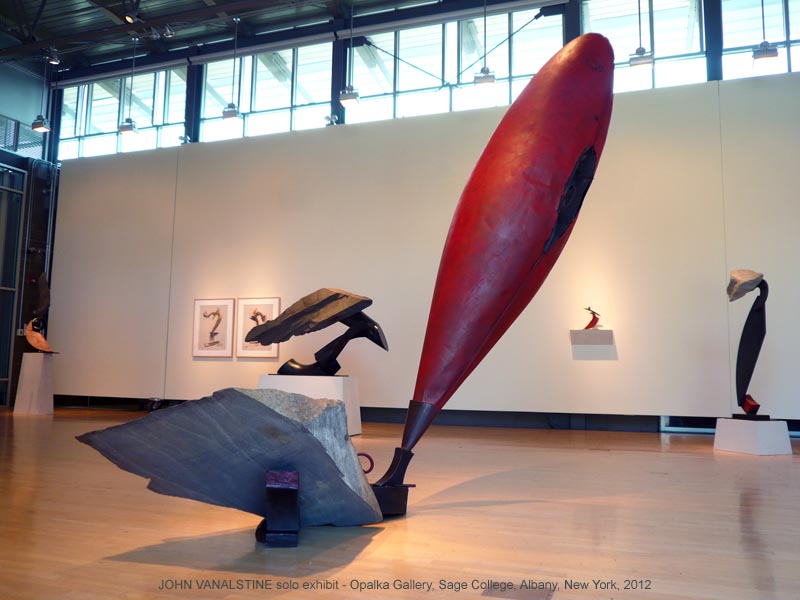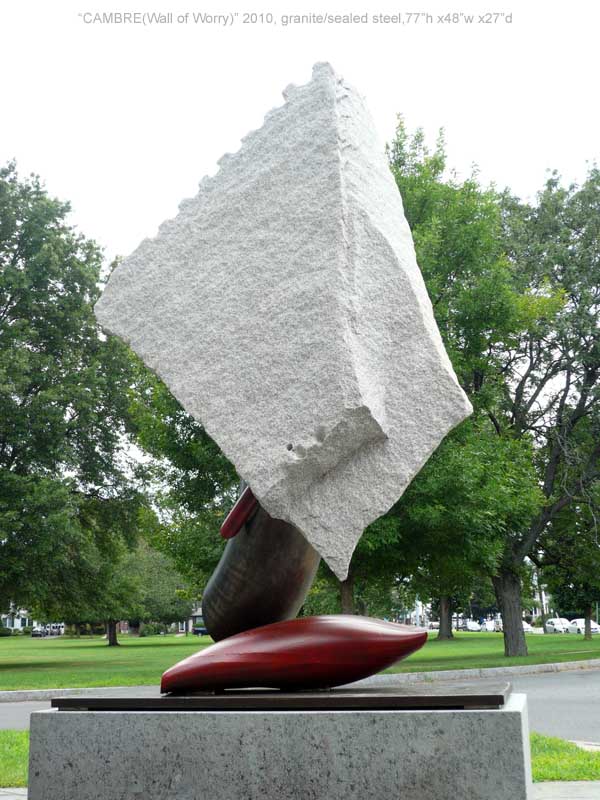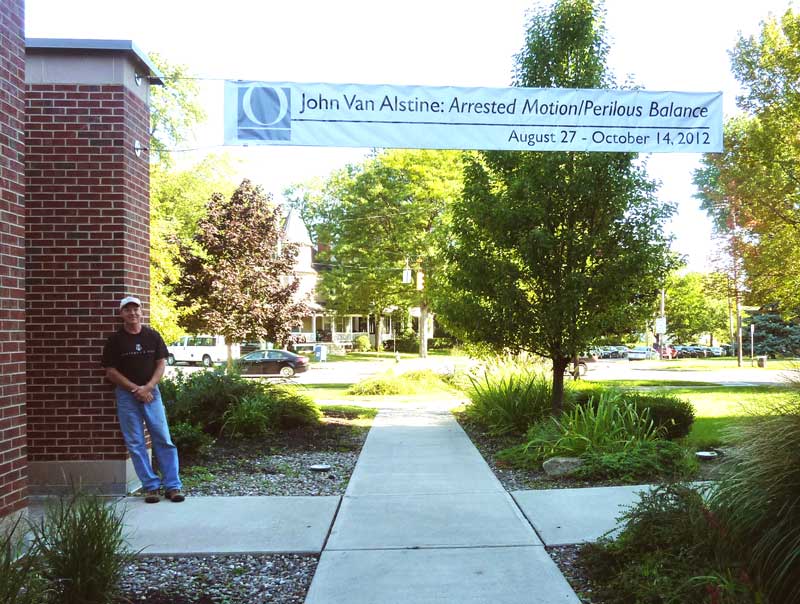Sculptor
Uses Found Objects to 'Choreograph' His Works
KAREN
BJORNLAND
Gazette Reporter
John
Van Alstine created "Rings of Unity -- Circles of Inclusion,"
a sculpture with a large stone suspended in a circle of bronze,
for the 2008 Summer Olympics in Beijing. From 1982 to 1996, his
work could be found in the Hirshhorn Museum's Sculpture Garden in
Washington. And this fall, if you drive or walk along New Scotland
Avenue, you'll see two of his sculptures outside of the Opalka Gallery
in Albany.
Curated by Ruth Hall Daly, "Arrested Motion/Perilous Balance,"
a solo exhibit by Van Alstine that opened Aug. 27, is not only a
rare Capital Region show for the internationally recognized artist,
it's the first time that the 10-year-old Opalka has shown sculpture
both indoors and outdoors.
A Johnstown High School grad who was one of the state's top skiers
was he was a teen, Van Alstine is now known for artworks that balance
natural stone and manmade objects in graceful and precarious positions.
Last year, he worked with sculptor Noah Savett to create "Tempered
by Memory," a 9/11 memorial in Saratoga Springs that was made
of steel beams from the destroyed World Trade Center. The 25-foot-tall,
12-ton sculpture was installed on July 24 in High Rock Park.
Van Alstine is the father of two grown daughters, Eden and Chloe,
and lives and works in the southern Adirondack town of Wells on
eight acres along the Sacandaga River in an old lumber mill that
he reclaimed and refurbished.
He shares his home and studio with his girlfriend, Caroline Ramersdorfer,
an Austrian-born artist whose carved stone sculptures have been
commissioned and shown around the world.
Van Alstine talked to The Gazette by phone from Wells in August,
a few days before he installed his exhibit at the Opalka.
Q: Is this the first time you've exhibited in Albany?
A: Yeah, I think it is. I haven't done a lot
in the Capital District. I don't really know why. I do a little
bit in Hudson and a little bit in Saratoga but it seems like most
of the time, it's in New York or Baltimore or Washington or Chicago
or Santa Fe. Even L.A. sometimes.
Q: What's in the show?
A: There are 19 sculptures, including five
that are pretty substantial pieces, and three that will be outdoors.
There will be three fairly substantial pieces inside, including
one in the entrance lobby, which is going to be really powerful.
I think it's one of the best spaces . . . with the beautiful wood
floors, and the open, high ceilings.
Q: How has your work changed from your solo show in 1999 at The
Hyde Collection?
A: Certainly the work still contains a kind
of signature of me, natural and manmade or human-made, but it's
evolved a little bit in the sense that one of the major pieces inside,
the piece called "Splay," is a little bit funkier. I have
done works like that, but they are spaced out in terms of time.
In the 1990s I did some, in the 2000s, I did some. And they're kind
of a spinoff of my vessel forms. Vessel is kind of a metaphor for
passage.
Q: What is that large red object in "Splay"?
A: It's called a drop tank. It's actually
an extra fuel tank for an airplane. They were designed to hook under
the wings and give extra fuel to the plane for long flights. I have
a piece called "Chalice," in which I've used a drop tank.
I actually cut the tank in half, and it made sort of like a big
tall cup.
Q: You like to use manmade objects from the 20th century. Are there
objects that you would never use?
A: I don't think I could make that statement. If it's an interesting
object, I'd love to try to use it somehow. But typically they are
industrial or marine or some kind of castoff or I find them in scrap
yards or marine salvage yards, and then somehow try to combine it
with found stone. I try to allow the spirit of the stone, if you
call it that, to speak, much in the same way if you were designing
a Japanese rock garden, where you put a stone according to its character
and spirit. You put that together with what I see as American industrial.
It kind of puts the idea of Eastern philosophy, Japanese, Chinese,
whatever, together with an American "can-do" spirit.
Q: Is finding the object part of your creative process?
A: Absolutely, yeah, and that's the fun part
of it. For me, it's an act of discovery when I'm out either looking
or not even looking, and I see something and say "wow, can
I fit that into my truck?" An example of that is the first
time that I used a big marine buoy. These things are five feet in
diameter. I was down in Florida at a wedding, and I had my little
pickup truck. I bought this giant steel ball, and it just fit in
the back of the truck, and I remember driving back on Interstate
95 and I would get so many looks, especially from kids that were
passing in family cars.
Q: What happens next with these found objects?
A: The second part is discovering how they
might go together. Sometimes you have an idea of where it's going
to go but the magic is allowing the things to speak back to you.
My work is very abstract but it also references the human body in
movement. So, for instance, some of the titles of pieces are gymnastic
moves, or refer to fencing or dance, like ballet. Like in the pieces
called "Pique a Terre," where I literally choreograph
an inanimate, heavy earthbound object.
Q: In the 1990s, you were collecting objects from a shipyard in
Jersey City. Where are you finding them now?
A: You know, I'm lucky. I've got a very good friend who has a scrap
yard in the Albany area. Everyone has gotten so litigious. Scrap
yards, quarries won't let you in.
Q: Where you find your stone?
A: I used to get a lot of stone in Vermont,
in Barre. That got shut down because of liability. So I began using
slate, which I can find where it's not in an official site, more
along the sides of the road.
Q: But slate is very different from granite.
A: It's not as durable, it's a lot tougher to work with, but it's
got a really interesting character. It's got this micro-macro character,
where you look at the textures and patinas on the slate. It's almost
like looking at a landscape from an airplane.
Q: Is your work best viewed outdoors?
A: I don't think so. Some works are certainly site-specific. They
deal with the movements of the sun in a specific way, like marking
the calendar or the solstice. Those obviously have to be outside.
And some of the big works, the scale demands generally that they
are outside. I think lighting is a real important part of sculpture,
controlling the light. Sometimes outdoor light, though it's really
nice, you can't really control it as well. I like indoor spaces
because of that.
Q: Where's the best outdoor place to see your work?
A: The pieces aren't there right now, but
they used to be in front of the Hirshhorn Museum in Washington,
D.C. In front of the Corcoran was another interesting place. I do
have work outdoors in a sculpture park called "Grounds for
Sculpture." That's a really big sculpture park near Princeton,
New Jersey. And I am very partial to my setting here, in Wells.
Q: How many sculptures are outdoors in Wells?
A: Maybe a dozen. Caroline has a couple big
ones sitting out as well.
Q: Can people visit your sculpture park?
A: Yes, by appointment.
Q: In your studio, you balance heavy pieces of stone and metal.
What sort of equipment do you use?
A: All kinds of lifts, chain hoists, gantries.
I'm always sort of juggling, getting these stones up or pieces of
steel up, with straps and chains and hoists, and I have three or
four of them going at once. When the moment is right, you go in
and you weld, and you fuse it that way.
Q: Is the sculpture you made for the Olympic Park in Beijing still
there?
A: It is. And Caroline's as well. There were 2,800 artists that
submitted. In 2007, we got an e-mail that we had been selected for
the final group and would you please put your idea together in a
maquette or small model. And they had a major exhibition in downtown
Beijing of all these pieces. They brought in an international jury,
and they narrowed it down. They invited the selected artists to
work in their factories, with their craftspeople, to realize the
sculpture on a large scale. It was amazing that we were both selected.
We went over and we worked with them. When we weren't working, they
gave a VIP trips to the Forbidden City and the Wall and the new
opera house. It was really nice.
Q: You also have a sculpture at Tsinghua University.
A: We both have works at the campus there
in Beijing. To celebrate the university's 100 years, they commissioned
100 large sculptures for the campus.
Q: What was it like to work with steel beams from the World Trade
Center, objects loaded with symbolism and emotion?
A: We were invited to the airport hangar at
JFK, and you walk into this gargantuan place, and you see all this
steel that's twisted. Twisted steel is kind of my natural material
but this was so incredible, partly because of the scale and then
it's imbued with the whole event, the symbolism and tragedy.
Q: After all the changes and delays, are you happy with High Rock
Park as the home for "Tempered by Memory"?
A: It was quite disappointing last year when
we missed our 10-year anniversary mark because we were racing towards
it, and in fact, if we had known that we had a little more time,
the sculpture would have changed a little bit. But it turned out
that this is a great site. It's more contemplative and more appropriate
to the kind of work that it is.
Q: When you were at Johnstown High, you were a champion skier. How
did you become an artist?
A: I was New York State Ski Meister for the high school circuit
two years in a row. Ski meister basically means a combination of
downhill-alpine events and cross-country. I went to St. Lawrence
thinking I might be a gym teacher because sports were such an important
part of my life. But, as a product of a liberal arts education,
I was turned on to making sculpture, and that really opened up some
doors. My father was sort of a builder-engineer, a hands-on guy.
My grandfathers were all carpenters, so in a way, what I do in sculpture
is not so different from what they traditionally did, it's just
with a little different direction.
Q: Do you still ski?
A: Absolutely. We love to ski. I think one of the reasons that she
[Caroline] can put up with the winters here is that we ski at Gore,
and we do a lot of snowshoeing. She grew up in the Alps. When we're
in Europe, we do a lot of skiing there.
Q: What else do you like to do when you are not making art?
A: In the summer, we're right on the river, so we're very much involved
in kayaking and fly fishing.
![]() September 2, 2012
September 2, 2012

